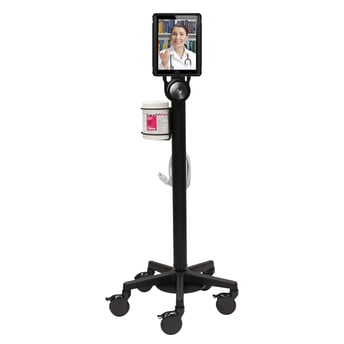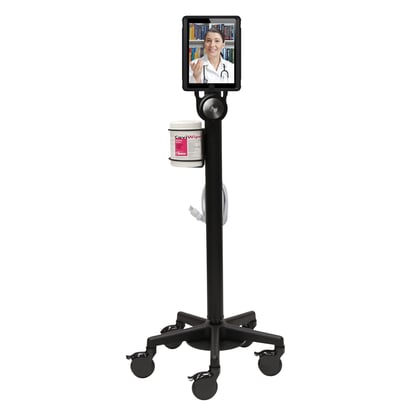By First Products on Nov 8, 2021 6:30:00 AM
Nurses have always had a tough job.
But while technology will never replace the empathetic, caring, and compassionate individuals who form the backbone of the nursing profession, some recent innovations are poised to make life far easier for nurses and patients alike.
Robotic Assistance with Repetitive of Physically Demanding Tasks

From medication management to lifting bedridden patients, nurses must perform a long list of monotonous and physically demanding tasks that can leave them exhausted at the end of a shift.
But thanks to advances in robotics technology, it no longer has to be this way.
Today’s healthcare robots can handle medical device transport, supply retrieval, food and drug delivery, and patient movement and transfer. Some robots can even engage in simple conversation, direct group entertainment programs, and provide companionship and affection to patients who might otherwise be lonely.
In the future, healthcare robots will even have the ability to triage patients in clinics, emergency departments, and via telehealth services, significantly streamlining care and standardizing symptom management in a way that utilizes far fewer resources.
Remote Communication Tech to Reach Rural and Underserved Communities
Telemedicine has gone mainstream during the COVID-19 pandemic.
From reducing unnecessary hospital visits to eliminating opportunities for infection, the digital technologies that enable remote connections between clinicians and distant patients have more than proven their worth.
Now the same innovations are poised to revolutionize telehealth nursing by giving nurses the ability to participate in triage from anywhere in the world; monitor blood pressure, glucose, respirations, heart rate, and other vital from afar; and even provide remote instructions to patients on how to dress a wound or treat a minor burn.
Telemedicine technology is also being used to train more nurses. In fact, according to the World Health Organization, “online or distance programs have been shown to increase access to rural and remote clinical facilities previously not associated with a “brick and mortar” education institutions.”
Artificial Intelligence to Eliminate "Alarm Fatigue"
Hospitals and other healthcare institutions experience as many as 187 alarms per bed per day, with false alarms accounting for 72% to 90% of these alerts.
Nurses can develop alarm fatigue when they become desensitized to the constant clatter of beeps coming from multiple medical devices usually present in a typical clinical setting. Once that fatigue sets in, even the best nurses might tune out the alarms that do require medical attention.
Fortunately, developments in Advances in Artificial Intelligence (AI) are on the horizon that could help eliminate alarm fatigue. For example, Duke University researchers have developed an algorithm to assess a patient’s risk for developing sepsis and automatically alert a hospital’s rapid response team to a high-risk case. Dubbed “Sepsis Watch," the algorithm can also guide the team through the first few hours of care administration – a critical period for preventing complications.
Portable Tech for Quicker, More Convenient Diagnosis
Thanks to the growing availability of pocket-sized, user-friendly tech, today’s nurses can easily pack a department’s worth of diagnostic devices in a medical bag or briefcase.
These tools will be especially useful in rural or underserved areas that lack convenient access to some services and specialists. In most cases, this technology facilitates sharing with remote providers via easy online uploads. By eliminating the need for massive ultrasound, ECG, and lab equipment, these revolutionary devices will ease patient evaluation and speed the delivery of needed care.
Virtual Reality Technology for Nursing Education
The technology that enables virtual reality, or VR, isn’t just for gamers.
In fact, about 65% of the nation’s nursing education programs are already incorporating virtual stimulation platforms into their programs, including VR. From practicing urinary catheter insertion to visualizing scenarios with unusual medical complications, VR technology is helping to ensure the nurses of tomorrow are practice-ready and prepared to deliver patient care when they enter the field.
Medication Management Technology
New technology is also poised to improve medication management.
Many health systems have already deployed chatbots, companion robots, and remote monitoring systems to communicate with and keep track of their patients. These same platforms can be programmed to provide daily medication reminders, a feature that’s especially useful for elderly patients living alone.
“Digital pills” have even been developed to help clinicians track patients’ adherence to medication regimens.
Portable Monitoring Technology
At most hospitals, it’s standard practice to check a patient’s vital signs hourly. The recent introduction of portable monitoring technology allows nursing staff to do so, even if they’re on the move or busy helping someone else.
These platforms ensure patient stats are continuously tracked and recorded at the appropriate time, no matter how busy the nursing team might be. They’re also capable of alerting staff anytime a patient needs immediate attention.
Automated IV Pumps
Technological advances are also revolutionizing the IV Pump.
In fact, automated IV pumps that allow nurses to alter dosage and drip rates from anywhere in the hospital are now widely available. Using these devices to automate medication reduces the potential for human error, ensures patients are never left waiting for needed adjustments, and frees nursing staff to focus more time on patient care.
Some automated IV pumps deliver needed nutrition at the appropriate times, and others allow patients to increase a controlled amount of pain medication for themselves.
Smart Beds and Lifting Devices
Thanks to smart technology, today’s patient beds can be equipped with movement sensors that help prevent falls, as well as low air-loss mattresses that automatically adjust pressure points based on preference and needs. Some smart beds even connect with EMR networks to help nurses better monitor patient data, including vitals and weight changes.
movement sensors that help prevent falls, as well as low air-loss mattresses that automatically adjust pressure points based on preference and needs. Some smart beds even connect with EMR networks to help nurses better monitor patient data, including vitals and weight changes.
During any typical day, a nurse may have to move multiple patients out of bed and into a wheelchair, assist them with standing, and help them turn to prevent bedsores. Thanks to smart technology, lifting devices that make these tasks safer for nurses and patients are also becoming increasingly available in hospitals throughout the country.
First Products: Committed to Improving the Lives of Nurses.
At First Products, we recognize the vital role nurses play in the lives of their patients and communities, and we're committed to supporting that mission in every way we can. From mobile workstations to EMR/EHR charting technology, all of our products and accessories are designed to ensure nurses, clinicians, and their patients reap the full benefits of today's healthcare technology revolution.
We've been working with healthcare professionals and medical providers for over 50 years. If First Products doesn’t already have your perfect-fit solution available, we'll customize one for you.
 To Learn More and to Arrange for Your Complimentary Demo, Contact First Products Today at 800.854.8304.
To Learn More and to Arrange for Your Complimentary Demo, Contact First Products Today at 800.854.8304.
_11wX8.5h-FINAL.png?width=721&name=FP-Logo-Horizontal-(COLOR)_11wX8.5h-FINAL.png)


comments